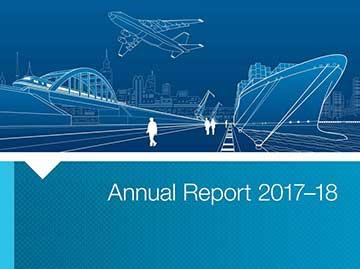The Australian Transport Safety Bureau (ATSB) has released its Annual Report, outlining its performance during 2017-18.

ATSB Chief Commissioner Greg Hood said the report describes the Bureau’s continual path of transformation.
“In my second year as Chief Commissioner, the team and I have continued to position the ATSB as a multi-modal, teams-based, world-class transport safety investigation agency,” Mr Hood said.
“We also prioritised the completion of a number of complex investigations, which delivered safety outcomes and also freed up key resources for new investigation priorities.”
With the Australian Government’s allocation of additional funding to address resourcing challenges encountered in previous years, Mr Hood said this funding has put the ATSB on a positive path of transformation.
“During the period, we recruited 17 new Transport Safety Investigators, who are already making an active contribution to transport safety,” Mr Hood said.
“The investment made over the period will see continued improvement towards the ATSB being able to meet its deliverable targets.
“We are investing significantly in the development of our investigators to position them to be able to disseminate safety findings to industry and the public as quickly as possible.”
With 16,522 incident and accident notifications received across the aviation, rail and marine transport modes in 2017-18, the Annual Report highlights some of the 40 complex investigations completed during the period, including the collision with terrain involving an Airbus Helicopters EC 135 T1 at Cooranbong, New South Wales in 2015.
“The safety message from this investigation was avoiding deteriorating weather conditions requires thorough pre-flight planning,” said Mr. Hood.
“Flying on into instrument meteorological conditions without a current instrument rating carries a significant risk of encountering reduced visual cues leading to disorientation.”
This investigation led to the launch ‘Don’t Push It, Land It’ – a safety initiative for the helicopter industry, developed in conjunction with the Australian Helicopter Industry Association (AHIA) and the Civil Aviation Safety Authority (CASA).
The ATSB also commenced some significant investigations in 2017-18, including the collision with water involving a DHC-2 Beaver floatplane, which occurred on the Hawkesbury River, north of Sydney, on New Year’s Eve.
ATSB Chief Commissioner Greg Hood said the report describes the Bureau’s continual path of transformation.
Over the next few years, the ATSB expects to see significant changes in the transport sector, with the increased use of automation or remotely piloted operations.
“Whilst we have restructured, we have maintained a strong focus on the quality of our evidence-based investigations. The focus in 2018–19 will be to make progress in addressing some of our key performance indicators around the timeliness for completion of reports,” Mr Hood said.
“I am confident that we can make good progress, particularly following our recent investigator recruitment exercise. The year will be a positive one, with our team committed to making our aviation, rail and marine modes of transport even safer.”


